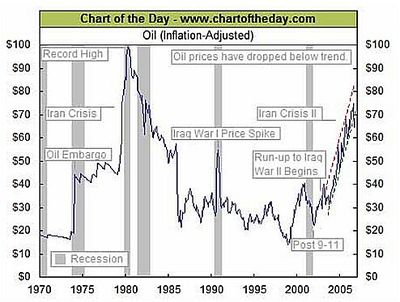Petroleum
 From Conservapedia
From Conservapedia Petroleum, named for "rock oil," is a fossil fuel usually found deep within the earth, although some deposits are very close to the surface.
It is a heavy dark liquid, consisting of many different hydrocarbon compounds. Wells are drilled deep in to the ground, and the crude oil is extracted and fractionated into its components by volatility in an oil refinery. Recent advances in drilling technology have enabled deeper and more difficult wells to be successfully drilled, allowing previously inaccessible reserves to be tapped.
As of June 6, 2017, crude oil was trading at about $48 a barrel, which is a relatively low inflation-adjusted price for the last decade. Twenty years ago, in late 1998, crude oil briefly fell to prices much cheaper than its market price today.
Contents
- 1 Petroleum products
- 2 Origins
- 3 Crude Oil and Total Petroleum imports to the United States
- 4 References
- 5 External links
Petroleum products[edit]
Some of the main products distilled from crude oil are shown in the table below. The table[1] compares the qualities of various types of petroleum:
| Fraction | API gravity | Viscosity (mp) |
|---|---|---|
| Gasoline | 60 | 6 |
| Kerosene | 50 | 20 |
| Diesel | 45 | 100 |
| Lubricating oil | 30 | 500 |
| Residuum | 10 | >105 |
Origins[edit]
Oil deposits are often found in concurrence with natural gas in a variety of geological structural or stratigraphic traps.
Petroleum is possibly of organic origin, believed by some scientists to be formed from the remains of vegetable material. Secular geologists have contended that petroleum is the remains of huge amounts of algal material that was laid down millions of years ago, and altered in form under high temperatures and pressures. Layers of buried plant material tend to produce coal or lignite.
Creationary geologists believe that petroleum was formed from organic material buried during the Noachian flood.
Recently, researchers have shown that natural gas can form rapidly,[2] and that some is still being formed. This gives support to the creationary view. If this research is supported it would refute the idea that fossil fuels are diminishing.[Citation Needed] It has also been posulated that oil and natural gas are formed continuously by an abiotic process, deep inside the earth.[3] These petroleum products constantly migrate from deep in the earth to the earth's crust where they can be effectively mined.[4] If this hypothesis is supported by further evidence, the notion of petroleum as a limited resource would be refuted.
The idea of abiogenic petroleum generation is, however, not supported by science and applications of this theory have yet to yield petroleum in any significant quantities.
Crude Oil and Total Petroleum imports to the United States[edit]

The top five exporting countries accounted for 64% of United States crude oil imports in February 2009 while the top ten sources accounted for 84% of all U.S. crude oil imports. The top sources of US crude oil imports for February 2009 were Canada (1.913 million barrels per day), Mexico (1.219 million barrels per day), Saudi Arabia (1.099 million barrels per day), Venezuela (0.960 million barrels per day), and Angola (0.671 million barrels per day).
Canada remained the largest exporter of total petroleum in February, exporting 2.512 million barrels per day to the United States. The second largest exporter of total petroleum to the United States was Mexico with 1.364 million barrels per day.[5]
| Country of origin | Feb-09 |
|---|---|
| Canada | 1,913 |
| Mexico | 1,219 |
| Saudi Arabia | 1,099 |
| Venezuela | 960 |
| Angola | 671 |
| Iraq | 554 |
| Nigeria | 457 |
| Brazil | 365 |
| Kuwait | 251 |
| Ecuador | 243 |
| Columbia | 225 |
| Equatorial Guinea | 167 |
| Algeria | 142 |
| Russia | 139 |
| Chad | 101 |
| Country of origin | Feb-09 |
|---|---|
| Canada | 2,515 |
| Mexico | 1,364 |
| Venezuela | 1,139 |
| Saudi Arabia | 1,115 |
| Angola | 671 |
| Iraq | 554 |
| Nigeria | 498 |
| Russia | 478 |
| Brazil | 381 |
| Algeria | 372 |
| Virgin Islands | 333 |
| United Kingdom | 285 |
| Kuwait | 251 |
| Ecuador | 243 |
| Colombia | 241 |
References[edit]
- ↑ Stainforth, J., Nourse, R. & Nosiara, M., 2007, Basin Oriented Geology - Petroleum Systems Module Course Manual.
- ↑ O’Donnell, E. 2005. “Rocks into Gas.” Harvard Magazine 107, no. 4.
- ↑ Gold, Thomas (1999). The deep, hot biosphere. Copernicus Books
- ↑ http://www.worldnetdaily.com/news/article.asp?ARTICLE_ID=59991
- ↑ Crude Oil and Total Petroleum Imports Top 15 Countries, Energy Information Administration, April 30, 2009
External links[edit]
- "What is in a Barrel of Oil?"
Categories: [Geology] [Energy] [Fuels] [Investments in Tangibles] [Economics]
↧ Download as ZWI file | Last modified: 03/01/2023 20:46:41 | 71 views
☰ Source: https://www.conservapedia.com/Petroleum | License: CC BY-SA 3.0
 ZWI signed:
ZWI signed: KSF
KSF